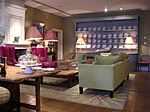Sir John Soane's Museum is a house museum, located next to Lincoln's Inn Fields in Holborn, London, which was formerly the home of neo-classical architect, John Soane. It holds many drawings and architectural models of Soane's projects, and a large collection of paintings, sculptures, drawings and antiquities that he acquired over many years. The museum was established during Soane's own lifetime by a Private Act of Parliament in 1833, which took effect on his death in 1837. Soane engaged in this lengthy parliamentary campaign in order to disinherit his son, whom he disliked intensely. The act stipulated that on Soane's death his house and collections would pass into the care of a Board of Trustees, acting on behalf of the nation, and that they would be preserved as nearly as possible exactly in the state they were at his death. The museum's trustees remained completely independent, relying only on Soane's original endowment, until 1947. Since then, the museum has received an annual Grant-in-Aid from the British Government via the Department for Digital, Culture, Media and Sport.
From 1988 onwards, a programme of restoration was carried out, with spaces such as the Drawing Rooms, Picture Room, Study and Dressing Room, Picture Room Recess and others, restored to their original colour schemes, and in most cases having their original sequences of objects reinstated. Soane's three courtyards were also restored with his pasticcio (a column of architectural fragments) being reinstated in the Monument Court at the heart of the Museum. In 1997 the trustees purchased the main house at No. 14 with the help of the Heritage Lottery Fund. The house was restored and has enabled the Museum to expand its educational activities, to re-locate its Research Library, and create a Robert Adam Study Centre where Soane's collection of 9,000 Robert Adam drawings is housed.
Some of Soane's paintings include works by Canaletto, Hogarth, three works by his friend J. M. W. Turner, Thomas Lawrence, Antoine Watteau, Joshua Reynolds, Augustus Wall Callcott, Henry Fuseli, William Hamilton and 15 drawings by Giovanni Battista Piranesi, many of which are framed and displayed in the museum. There are over 30,000 architectural drawings in the collection. Owing to the narrow passages in the house, all decked with Soane's extensive collections, only 90 visitors are allowed in the museum at any given time, and a formation of queue outside for entry is not unusual. Labels are few and lighting is discreet; there is no information desk or café. In the year ending March 2019, the museum received 131,459 visitors.











